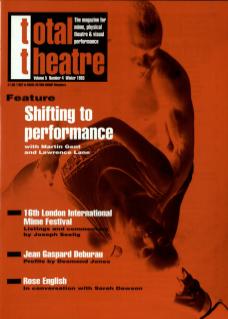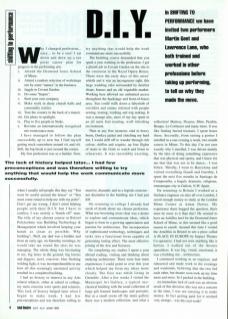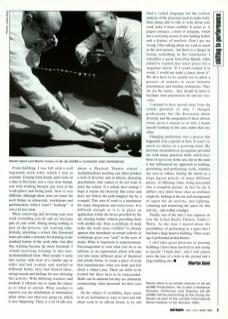Why I changed profession... easy... to be a star! I sat down and drew up a ten point career plan for progress in the performing arts.
i. Attend the Desmond Jones School of Mime.
ii. Attend a random selection of workshops run by some ‘names’ in the business.
iii. Juggle in Covent Garden.
iv. Do some ‘Impro’.
v. Start your own company.
vi. Make work in dusty church halls and community centres.
vii. Tour the country in the back of a transit.
viii. Get photo in Spotlight.
ix. Play to five people in Stoke.
x. Become an internationally recognised neo-renaissance man.
I have managed to follow the plan successfully up to now but I find myself getting stuck somewhere around vii and viii. Still, the big break is just around the corner.
My first profession was as a builder. Now, when I usually tell people this they say ‘You must be useful around the house’ or ‘You must come round to help me with my patio’. Don't get me wrong, I don't mind helping people with their D.I.Y. but I have to confess I was strictly a ‘hands off’ man. The title of my chosen course at Bristol Polytechnic was Building Technology & Management, which involved keeping your hands as clean as possible. Why building? Well, my dad was a builder and from an early age, on Saturday mornings, he would take me round the sites he was managing. The whole thing was fascinating to me, big holes in the ground, big lorries and diggers, steel, concrete, blue flashing welding light, it was incomprehensible to me how all this seemingly unrelated activity resulted in a completed building.
I had no history or interest in any Arts related subjects, either at school or college, my main concerns were sports and sciences. This lack of history helped later when I began to make work. I had few preconceptions and was therefore willing to try anything that would help the work communicate more successfully.
The building course demanded that you spent a year working in the profession. I got a plumb job in Covent Garden on the site of the extension to the Royal Opera House. These were the early days of this area’s rebirth and it was an incongruous sight, this large wedding cake surrounded by derelict shops, houses and an old vegetable market. Working here allowed me unlimited access throughout the backstage and front-of-house area. You could walk down a labyrinth of corridors and rooms infested with people sewing, ironing, washing and wig making. It was a strange mix, most of my day spent in an all-male, Sun reading, wolf whistling environment.
Then at any free moment, clad in heavy boots, Donkey jacket and clutching my hard hat, I would drift off to wander through rich colour, chiffon and sequins, up four flights of stairs to the Gods to watch and listen to rehearsals. It was incredibly exciting – massive, dramatic, and as a logistic exercise not dissimilar to the building site I had just left.
On returning to college I already had seeds of doubt about my chosen profession. What was becoming more clear was a desire to explore and communicate ideas, which began to form in a growing appreciation of and passion for architecture. The incorporation of sophisticated technology, techniques and tasks into a functional form capable of generating lasting effect. The most effective joining of the Arts and Sciences.
On completing my studies I spent a year abroad reading, visiting and thinking about studying architecture. There were four main experiences I could point to over this year which helped me form my ideas more clearly. The first was while living in Grenoble. After a few weeks I visited the Municipal Art Gallery, a typical neoclassical building with the usual collection of large gilt-framed landscapes and portraits. But in a small room off the main gallery there was a modern collection, and what a collection! Matisse, Picasso, Miró, Picabia, Braque, Le Corbusier and many more. It was like finding buried treasure. I spent hours there. Secondly, from seeing a poster I enrolled in a one evening a week, two-month course in Mime. To this day I'm not sure exactly why I enrolled. I was driven mainly by the idea of doing something expressive that was physical and sporty, and I knew for me that that was not to be dance... I was bitten. Thirdly, I went to Barcelona and visited everything Gaudi, and fourthly, I spent the next five months in Santiago de Compostela, a hugely dramatic, religious, romanesque city in Galicia, N.W. Spain.
The lack of history helped later... I had few preconceptions and was therefore willing to try anything that would help the work communicate more successfully.
On returning to Britain I worked as a freelance engineer on sites all over London and saved enough money to study at the London Mime Centre at Adam Darius. My experience there begged the question, there must be more to it than this? He seemed to have an Achilles heel for the Desmond Jones School of Mime, so this seemed like a good reason to enrol. Around this time I visited the Arnolfini in Bristol to see a piece called A Place in Europe by Impact Theatre Cooperative. I had not seen anything like it before. I walked out of the theatre speechless. It was big, visual, emotional, it was a building site... architecture.
I continued working as an engineer, and rehearsed and made work in the evenings and weekends, believing that the two fed each other, but theatre soon took up my time more and more. So I packed in the building.
An immediate lack of cash was an obvious result of this decision, this was not a concern at the time, I was not entering it to make money. In fact getting paid for it seemed very strange... was this real work?
From building, I was left with a well ingrained work ethic which I had to examine. Coming from hourly paid work on a nine to five basic was a very clear format – you were working because you were at the work place and being paid. Now it was different, although there were set times for such things as rehearsals, workshops and performances, when I wasn't ‘working’ – it was a lot less clear.
When conceiving and devising your own work everything you do and see becomes part of your work. Sitting doing nothing is part of the process, not wasting time. Initially, attending a school like Desmond Jones provided a structure for learning in the standard format of the work ethic, but after this, training became far more fractured. I valued receiving training in this non-institutionalised form. Most people I came into contact with were of a similar age or older and had worked and studied in different fields; they had formed ideas, strong reasons and feelings for now choosing this activity. With differing teachers and methods it allowed one to make the choice as to what to attend. What needed to improve was the distribution of information about where and what was going on, which is now happening. There is a lot of talk now about a Physical Theatre school – institutionalised teaching can often produce a lack of diversity and an elitism, alienating practitioners who cannot or do not want to enter the school. If a school does emerge 1 hope it retains the diversity that exists and does not follow the path mapped out by a svengali. This area of work is a touchstone for many integrations and cross-overs. It is difficult enough as it is to place an application within the boxes provided by the arts funding bodies without providing them with another one. Does a certificate of study make the work more credible? It already appears that attendance at certain schools or workshops gives you ‘cred’ in the eyes of many. What is important is empowerment. Encouragement to treat what you do as an artform, as an exploration which will take you into many different areas of theatrical and artistic forms, to create a piece of work that communicates what you think and feel about a subject area. There are skills to be learned but these have to be transcended. Skills can be admired but they are ultimately uninteresting when presented for their own sake.
On the subject of credibility, there seems to be an inclination to want to meet and talk about work in an official forum, to try and find a verbal language for the critical analysis of the processes used to make work. Does being able to talk or write about your work make it more credible? It seems to. A jargon emerges, a kind of artspeak, which has a worrying accent of arts funding bodies and a dialect of intellect. Don't get me wrong, I like talking about my work as much as the next person... but there is a danger in losing something in the translation. I remember a quote from Pina Bausch, when asked to explain her latest piece for a magazine article: ‘If I could explain it in words, I would not make a dance about it.’ We also have to be careful not to allow a process of osmosis to occur between practitioners and funding institutions. They are not the enemy – they should be there to facilitate what practitioners do and not vice versa.
I seem to have moved away from the initial question of why I changed professions, but the discussion about diversity and the integration of those diverse forms gives a reason as to why I found myself working in this area rather than any other.
Changing professions was a process that happened over a period of time. It wasn't so much a choice as a growing need. My previous incarnation as an engineer provided me with many practical skills which have been of use to me in the arts, but in the main it has influenced my approach to making, presenting and performing work, whether my own or others. Seeing the whole as a large jigsaw puzzle, of many different pieces, of differing value, being persuaded into a complete picture. In fact for me it differs very little from what an architect might do, looking at the use and arrangement of space for an activity, and lighting, colouring and texturing the space for that activity... and within a budget.
Finally, one of the sites I was engineer on was the Lilian Baylis Theatre, Sadler's Wells. At the time I mused about the possibilities of performing in a space that I had had a large hand in building. Three years ago I performed in that theatre.
I still take great pleasure in passing buildings I have been involved in and saying to myself ‘I built that’, and I still cannot resist the lure of a hole in the ground and a large building site.
Martin Gent is an artistic director of dA dA dUMB Productions. He is also a freelance Director, Performer and Teacher. dA dA dUMB will be performing at the Young Vic Studio as part of the London International Mime Festival 17-22 January 1994.


